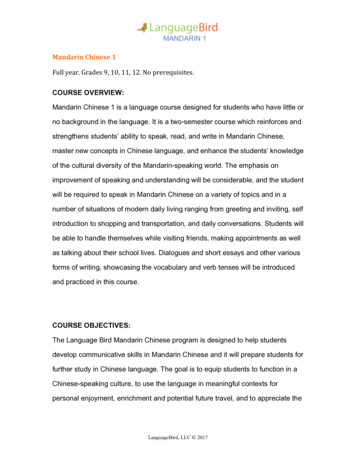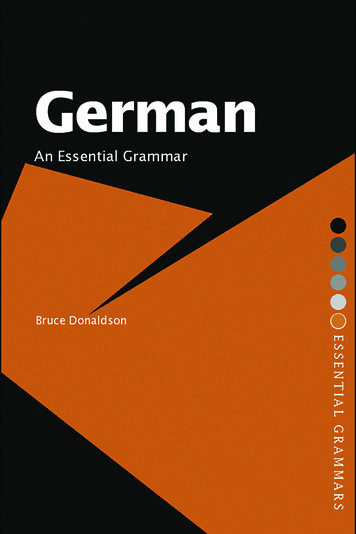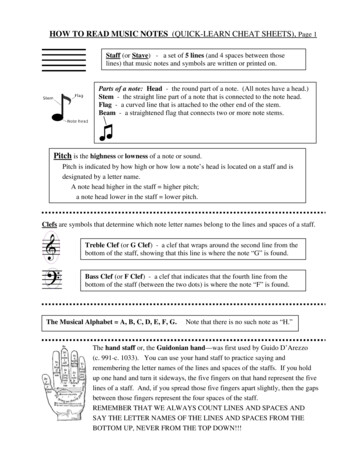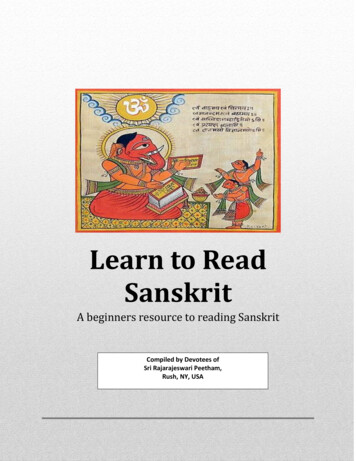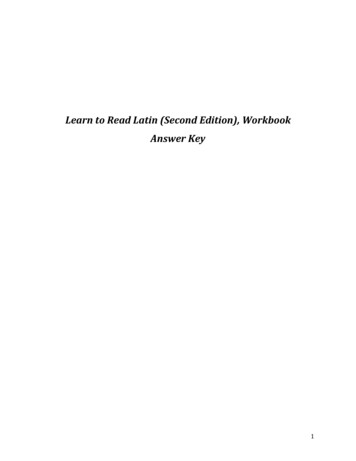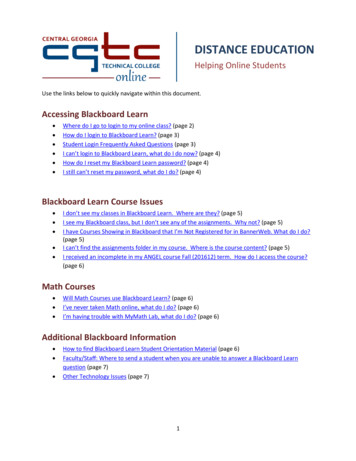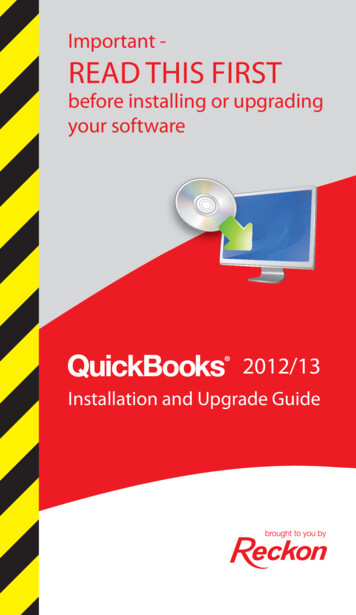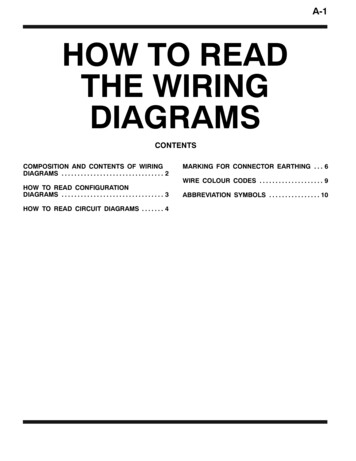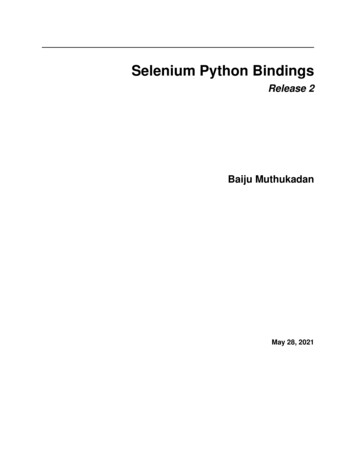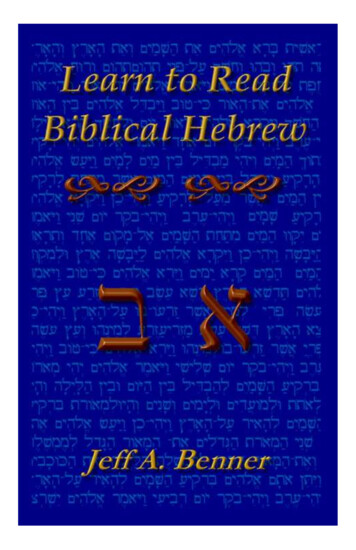
Transcription
Learn to ReadBiblical Hebrew
Learn to Read Biblical Hebrew2
Learn to Read Biblical HebrewLearn to Read Biblical HebrewA guide to learning the Hebrewalphabet, vocabulary and sentencestructure of the Hebrew Bible By Jeff A. Benner3
Learn to Read Biblical HebrewCover design by Jeff A. Benner.“Learn to Read Biblical Hebrew,” by Jeff A. Benner.Published 2007 by Virtualbookworm.com Publishing Inc.,P.O. Box 9949, College Station, TX 77845, US. 2003,Jeff A. Benner. All rights reserved. Any part of this bookmay be copied for educational purposes only, withoutprior permission.Manufactured in the United States of America.4
Learn to Read Biblical HebrewTable of ContentsINTRODUCTION .7PART 1 THE ALEPHBET . 11LESSON 1 – ALEPH, BEYT . 15LESSON 2 – MEM, YUD . 17LESSON 3 – NUN, HEY. 19LESSON 4 – LAMED, VAV . 21LESSON 5 – RESH, SHIN . 23LESSON 6 – AYIN, TET . 25LESSON 7 – TAV, DALET. 27LESSON 8 – TSADE, QUPH . 31LESSON 9 – CHET, KAPH . 33LESSON 10 – ZAYIN, PEY . 35LESSON 11 – GIMEL, SAMECH . 37LESSON TRANSLITERATIONS. 39PART 2 READING PRACTICE . 45THE HEBREW . 46TRANSLITERATION . 49PART 3 REFERENCE GUIDE . 53PART 4 TRANSLATING LESSONS . 59LESSON 1 – GENESIS 1:1. 61LESSON 2 – GENESIS 1:2. 66LESSON 3 – GENESIS 1:3. 72LESSON 4 – GENESIS 1:4 & 5 . 76PART 5 HEBREW/ENGLISH DICTIONARY . 78PART 6 PARENT / CHILD ROOTS . 98PART 7 ADOPTED ROOTS . 1245
Learn to Read Biblical HebrewTo my Father who set me on thepath of Biblical studies6
Learn to Read Biblical HebrewIntroductionWhy Learn Hebrew?A translation of the Biblical text is a translator's"interpretation" of the text. The translator's beliefs willoften influence how the text will be translated and anyoneusing his translation is seeing it through his eyes ratherthan the original authors. Only by studying the originallanguage of the Bible can one see the text in its originalstate.Learning the Hebrew language can be both fun andexciting. By simply studying the pages that follow, for justa few minutes a day, you will soon be reading Hebrew,build a Hebrew vocabulary and even begin translatingBiblical passages for your self.About HebrewThe English word "alphabet" is derived from the first twoletters of the Greek Alphabet--Alpha and Beta. Hebrew onthe other hand, uses the word "alephbet," the first twoletters of the Hebrew alephbet--aleph and bet. The Hebrew7
Learn to Read Biblical Hebrewalephbet consists of 22 consonants. The vowels (callednikkudot, nikkud in the singular) are dots and dashesadded above and below the consonants. One advantage toHebrew is that the sound for each letter remainsconsistent, unlike English where one has to memorizemany variations. For instance, the word circus contains theletter "c" twice, the first time it is pronounced like an "S"while the second time it is pronounced like a "K." InHebrew, the letter K is always pronounced as a "K."Unlike English, which is read from left to right, Hebrew isread from right to left just as many other Semiticlanguages do including Aramaic and Arabic. This maysound difficult at first but in a very short time you will getused to it.When sounding out a word, it will be easier if youremember the Consonant (C) and Vowel (V) patterns ofHebrew words. In English, the consonants and vowelsmay be arranged in any order, such as in the word "circle"which has a C V C C C V pattern. Hebrew on theother hand, is very consistent, and each word will usuallyfollows a C V C V C. pattern. The Hebrew word %,l,m(melek - king) contains the pattern C V C V C, Ak,l,m(meleko – his king) is C V C V C V and %,l,m'h(hamelek – the king) is C V C V C V C.The pronunciations of some of the consonants and vowelshave changed over the centuries but this does not affectthe meaning of words as the letters of the words define it,and not the sounds. We will learn to pronounce themaccording to the Modern Hebrew pronunciation. ModernHebrew pronunciation is also divided into two parts,Ashkenazi and Sephardic. Since Sephardic is the8
Learn to Read Biblical Hebrewpronunciation adopted by the Modern State of Israel, wewill use this pronunciation.About this BookWhen I began to study the Hebrew language I used severaldifferent resources but found that they were not compiledin a format for beginning Hebrew students. I began toarrange charts and lists with the necessary information as aready resource for learning and reading the Hebrew Bible.This book is the result. Included in this book are lessonsfor learning the alephbet, verbs, nouns, adjectives andsentence structure.If at any time you have questions about the AncientHebrew Research Center, this book, its content or thelessons, please feel free to E-mail your questions orcomments to us through our web site;http://www.ancient-hebrew.orgAdditional ResourcesIt should be kept in mind that this book is not meant to beused for in-depth Biblical study, but as a reference guidefor Biblical reading practice, vocabulary building andsentence comprehension. More specific dictionaries andlexicons will be necessary for more in-depth study.9
Learn to Read Biblical HebrewThrough the process of Hebraic studies, you will want todig deeper into the meaning of specific words and phrases.At this point the purchase of a Hebrew Bible and aHebrew Lexicon will be helpful. There are several differentkinds of Hebrew Bibles. The standard Hebrew Bible willbe a Bible written only in Hebrew. The Interlinear Biblewill have the Hebrew on one line and the Englishtranslation for each word under each Hebrew word. AParallel Bible will have the Hebrew text on one page andthe English translation on the otherThere are several different Lexicons but be sure that theone you purchase includes all the words of the Bible withthe prefixes and suffixes attached. This will allow you tolook up a word even if you do not know the root. Irecommend Benjamin Davidson's Hebrew and ChaldeeLexicon of the Bible.10
Learn to Read Biblical HebrewPart 1The AlephbetEach of following eleven lessons introduces two newconsonants and may or many not introduce new vowels.Each lesson will also include a practice section, newvocabulary words and sentences. The practice session willallow you to practice the new letters and vowels andrefresh yourself on old ones. The vocabulary section willconsist of a few words using the new letters and vowels tobegin building your Hebrew vocabulary. The Sentenceswill allow you to begin using your new words insentences.To assist you in learning the letters and words, Irecommend that you put the letters and words you arelearning on flashcards so that you can study them at anytime.Transliterations of each of the lessons are provided at theend of the lessons to assist with pronunciation. Whenreading these transliterations, remember to use the correctHebrew sound for each vowel. For example thetransliterated Hebrew vowel sound "o" is the long "o"sound as in the English word "rope."11
Learn to Read Biblical HebrewAlephbet and VowelsThe following is a chart of all the consonants in theHebrew Alephbet. This chart includes all the variations foreach letter. For example the letter beyt can be written as Bor b. Several of the letters have a final form as well andare also included (such as m and ).LamedMemNunSamechAyinPeyTsadeQuphReshShinTavl etYudKaph12aBbgdhwzxjy& Kk
Learn to Read Biblical HebrewThe VowelsBelow are the names for each of the Hebrew vowels. Theletter aleph is used below to show the placement of eachvowel and is not part of the vowel.Cholam maleyQubbutsShuruqChataph qamatsChataph patachChataph olam13'a;a,aea.aiaoa
Learn to Read Biblical HebrewLetter ComparisonsSeveral of the Hebrew letters are very similar and at thebeginning they are easily confused with other letters thatlook alike. Below is a chart showing letters of similarity inorder to make the reader familiar with the yTavbkDaletbpgnhxhtVavReshZayinVavF. NunZayinF. NunChetTavdrKaphwzw!z!xtMem14PeyTetF. MemSamechSamechTetAyinTsadekpmj ssj[c
Learn to Read Biblical HebrewLesson 1 – aleph, beytConsonantsaThe "Aleph" is the first letter of the Hebrewalephbet. This consonant is silent.bThe "Beyt" is pronounced two ways, a "b" as in"ball," and as "v" as in "visit." When a dagesh (a dotin the middle of the letter) appears in the middle ofthe letter (B) it will have the "b" sound. When theletter appears without the dagesh (b) the letter ispronounced "v."Vowelsa'This vowel, "qamats," (the little "T" shaped markunder the aleph) is pronounced "ah" as in "father."a;This vowel, "patach," is also pronounced "ah" as in"father."Practice'b ;a 'a 'B ;a 'a ;B 'b ;a ;B 1a'B b'a a'B b'a a;B a'b 215
Learn to Read Biblical HebrewVocabularyCame -a'B 2Father -b'a 1SentencesFather came. -16a'B b'a 1
Learn to Read Biblical HebrewLesson 2 – Mem, YudConsonantsmThe "Mem" is pronounced "m" as in "mother." The "final Mem" is used only when it appears at theend of a word. The pronunciation does not change.yThe "Yud" is pronounced "y" as in "yes." (Whenthe "yud" is suffixed to a word it means "of me" or"my." Sentence #2 includes the word b'a - father,with the suffixfather.)yforming the wordyiba'- myVowelsaiThe "chireq" is pronounced "ee" as in "bee."aeThe "tsere" is pronounced "ey" as in "grey."Practice;m ' em im ia ea iB eb eB ib 1 ia ea yim yiB yib yia yea 217
Learn to Read Biblical HebrewVocabularyWho -yim 2Mother - ea 1Sentencesa'B yim 1My father came. - a'B yiba' 2Who came? -18
Learn to Read Biblical HebrewLesson 3 – Nun, HeyConsonantsnThe "Nun" is pronounced "n" as in "no."!The "final Nun" is only used when it appears at theend of a word. The pronunciation does not change.hThe "Hey" is pronounced "h" as in "hello." (Whenthe letter h is prefixed to a word it means "the"such as in sentence #6 where the letter h is prefixedto the wordprophet.)ayibn" - prophet, forming ayibn" 'h - thePracticeb;h h'B !eB yEn En In :n eh ih ;h 'h 1a"n !im h'm b"n hEn hIn h"n !eh !;h 2h"n'B h'b"n1 !ih yeh yEn ayIn yIn ayih yih 31Hebrew words with more than one syllable usually accent the finalsyllables pronouncing the final Consonant-Vowel-Consonant as onesyllable. For instance, the word yIn'a, in the vocabulary list, ispronounced "a-niy" rather than "an-iy."19
Learn to Read Biblical HebrewVocabularyyIna' 2Son - !eB 4Prophet - ayib"n 6yeaShe – ayihcame (f.) - h'aB'What - h'm or h;mWhere –I- 1 3 5 7Sentencesayih yimMy son came. - a'B yIneB3I [am a] father. - b'a yIn'aWhere [is] my father? - yib'a yeaWhat [is a] prophet? - ayib"n h'mThe prophet came. - a'B ayib"n'h2Who [is] she? -4 1 2 3 4 5 62The English verb "to be" and its various tenses (am, is, are, etc.) donot exist in Hebrew and need to be added in the translation.3English has two indefinite articles, "a" and "an" which also do notexist in Hebrew and must be added in the translation.4When the letter h is prefixed to a word it means "the" such as insentence #6 where the letter h is prefixed to the word ayib"n (prophet)forming ayib"n'h, meaning "the prophet."20
Learn to Read Biblical HebrewLesson 4 – Lamed, VavConsonantslThe "Lamed" is pronounced "l" as in "long."wThe "Vav" is pronounced "v" as in "visit."Vowelsa.The "sh'va" is pronounced "eh" as in "help" when itis placed under the first letter of the word. Whenthis vowel appears anywhere else in the word, it isusually a "syllable break" and not pronounced.a,The "segol" is pronounced "eh" as in "help."PracticeyEw y:w y'l5 yil y;l yIw "w w 'l il ,l ;l el 1l'h h'l leh hel l:w lEw l w l,l w"w w w 2aelm' h'm.bel lIy;l h'Bil yIww" 35When one of the "a" vowels (qamats or patach) is followed by theconsonant "yud" in the same syllable, the pronunciation is a long "i"as in "lie" and NOT "ay" as in "lay."21
Learn to Read Biblical HebrewVocabularylea 2Believe - !em'a 4Sea - "y 6h'ly. ;l 1Water - Iy;m 36Here - hENih 5God -Night -Sentencesa'B h'l.y;l7Water [is] in the sea. - "y;B Iy;m8My son came to me. - yil a'B yIneB9Mother came in the night . - h'ly ;l;B h'a'B eahENih yiMea w10 yib'aNight came. - 1 2 3 4 5My father and my mother [are] here. 6When the dagesh (the dot in the middle of a letter) is placed withinsome letters, such as in the nun in t
Learn to Read Biblical Hebrew 8 alephbet consists of 22 consonants. The vowels (called nikkudot, nikkud in the singular) are dots and dashes added above and below the consonants. One advantage to Hebrew is that the sound for each letter remains consistent, unlike English where one has to memorize many variations. For instance, the word circus contains the
